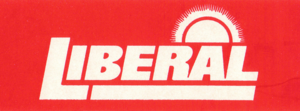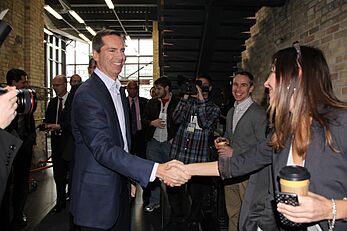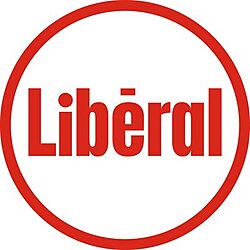Ontario Liberal Party facts for kids
Quick facts for kids
Ontario Liberal Party
Parti libéral de l'Ontario
|
|
|---|---|
| Abbreviation | OLP PLO |
| Leader | Bonnie Crombie |
| President | Kathryn McGarry |
| Parliamentary leader | John Fraser |
| House leader | Lucille Collard |
| Founded | 1857 |
| Preceded by | Clear Grits |
| Headquarters | 344 Bloor Street W. Suite 404 Toronto, Ontario M5S 3A7 Canada |
| Youth wing | Ontario Young Liberals |
| Women's wing | Ontario Women’s Liberal Commission |
| Membership (2023) | |
| Ideology | Liberalism (Canadian) |
| National affiliation | None |
| Colours | Red |
| Seats in Legislature |
14 / 124
|
The Ontario Liberal Party (OLP) is one of the main political parties in the province of Ontario, Canada. A political party is a group of people with similar ideas about how to run a government. The party's current leader is Bonnie Crombie, who was elected in December 2023.
The OLP is connected to the federal Liberal Party of Canada, but they are two separate organizations. This means they have their own leaders, rules, and members, although many people support both.
The party follows the ideas of liberalism. In Ontario's political world, the Progressive Conservative Party is generally seen as being to the right of the Liberals, while the New Democratic Party (NDP) is to their left.
After governing Ontario for 15 years, the Liberals had a major defeat in the 2018 election. They won only seven seats, which was not enough to keep their official party status. In the 2022 election, they won eight seats. In the 2025 election, under Bonnie Crombie's leadership, the party won 14 seats and regained official party status.
Contents
History of the Party
How the Party Began
The Ontario Liberal Party started from the Reform Party in the 1830s and 1840s. Leaders like Robert Baldwin and William Lyon Mackenzie wanted responsible government, which means the government should be accountable to the people's elected representatives.
The modern Liberal party was formed in 1857 by George Brown. He brought together different groups, including the "Clear Grits" from southwestern Ontario. They wanted democratic reforms and supported the idea of Canadian Confederation, which was the joining of Britain's colonies to create the country of Canada in 1867.
Early Years in Government
After Confederation in 1867, Edward Blake became the leader of the Ontario Liberals. He defeated the Conservatives in the 1871 election. Soon after, Blake moved to federal politics, and Oliver Mowat took over as leader and Premier of Ontario.
Mowat was premier for a very long time, until 1896. Under his leadership, the Liberals tried to be a party for everyone, including both Catholics and Protestants, and people from both cities and rural areas.
A Long Time in Opposition
After being in power for over 30 years, the Liberals lost the 1905 election. The party had become disorganized and lost touch with many voters. For many years, they struggled to win elections and were even smaller than the United Farmers of Ontario for a while.
The party was so disorganized that for seven years it was led by an interim leader, W.E.N. Sinclair, because they couldn't hold a proper leadership vote. By the 1930s, the Liberals were a small party with most of their support in rural areas.
Return to Power with Mitch Hepburn
The party's fortunes changed when they chose Mitchell Hepburn as their leader in 1930. Hepburn was a farmer and a skilled politician who brought new energy to the party. He was able to unite different groups of voters, including farmers, city dwellers, Catholics, and French-speakers.
When the Great Depression hit, people were looking for a change. Hepburn's exciting style helped the Liberals win the 1934 election. However, his government had major disagreements with unions and with the federal Liberal government of Prime Minister William Lyon Mackenzie King. These conflicts divided the party and led to their defeat in the 1943 election.
The Post-War Years
For the next 42 years, from 1943 to 1985, Ontario was governed by the Progressive Conservatives, also known as the Tories. During this time, the Liberal Party was mostly a small, rural party.
In the 1960s and 1970s, the Liberals had very little support in big cities like Metropolitan Toronto. For a time, it seemed like the NDP might replace them as the second-biggest party.
The Peterson Government
In 1985, under the leadership of David Peterson, the Liberals finally broke the Tories' long hold on power. Peterson modernized the party, making it more popular with voters in cities and with new immigrants.
From 1985 to 1987, Peterson led a minority government. He made a deal with the NDP, who agreed to support the Liberals in exchange for the government passing certain laws. When the deal ended, Peterson called an election in 1987 and won a huge majority government with 95 seats.
However, the government's popularity didn't last. In the 1990 election, many voters were unhappy that an election was called after only three years. The Liberals ran a poor campaign and lost badly to the NDP, led by Bob Rae. The party's number of seats fell from 95 to 36.
The McGuinty-Wynne Era
The Liberals returned to opposition. In 1996, they chose Dalton McGuinty as their new leader. After losing the 1999 election to the Progressive Conservatives, McGuinty and the Liberals worked hard to rebuild.
Winning in 2003
In the 2003 election, McGuinty led the Liberals to a majority government, winning 72 of 103 seats. His campaign focused on positive messages about improving schools and healthcare.
One of the new government's first major decisions was to create a "Health Premium," which was a new tax based on income. This broke a key campaign promise not to raise taxes. McGuinty said the tax was necessary to pay for promises in healthcare and education and to fix a budget deficit left by the previous government.
The McGuinty government also created the Greenbelt, a large area of protected land around Toronto, and banned smoking in public places.
Three Terms in Government
The Liberals won again in the 2007 election and the 2011 election, making McGuinty the first Liberal leader in 70 years to win three elections in a row. In 2012, McGuinty stepped down as leader.
Kathleen Wynne was elected as the new leader in 2013, becoming Ontario's first female premier. In the 2014 election, she led the Liberals to another majority government. One of her government's major policies was selling a large part of Hydro One, the province's electricity utility.
Losing Official Party Status
In the 2018 election, the Liberals suffered the worst defeat in the party's history. Their support dropped sharply, and they won only seven seats. This was not enough to keep their official party status, which means they lost funding and the right to ask as many questions in the legislature. Wynne resigned as leader on election night.
Steven Del Duca became the new leader in 2020. In the 2022 election, the party won eight seats, still not enough for official status. Del Duca resigned after failing to win a seat himself.
Leadership of Bonnie Crombie
In December 2023, the party elected Bonnie Crombie, the popular mayor of Mississauga, as its new leader. She promised to rebuild the party and offer a strong alternative to the government.
In the 2025 election, the Liberals won 14 seats. This was enough to regain official party status in the Ontario Legislature, an important step in the party's rebuilding process.
Current Liberal Members of Provincial Parliament
As of the 2025 election, these are the members of the Ontario Liberal Party who have seats in the provincial legislature.
| Member | Elected | District | Notes |
|---|---|---|---|
| Rob Cerjanec | 2025 | Ajax | Economic Development and Innovation, Tourism, Sport and Culture |
| Mary-Margaret McMahon | 2022 | Beaches—East York | Critic for the Environment and Climate and Emergency Management |
| Adil Shamji | 2022 | Don Valley East | Chief Whip
Critic for Housing, Primary Care, Urgent Care and Public Health, and Indigenous Affairs. |
| Jonathan Tsao | 2025 | Don Valley North | Critic for Citizenship and Immigration, Community, Social Services, Children and Youth |
| Stephanie Bowman | 2022 | Don Valley West | Deputy House Leader
Critic for Finance and Treasury Board, Interprovincial Trade, Tariffs and International Trade |
| Lee Fairclough | 2025 | Etobicoke—Lakeshore | Critic for Hospitals, Mental Health, Addictions and Homelessness |
| Karen McCrimmon | 2023 | Kanata—Carleton | Critic for Public Safety, Cybersecurity and Crime Prevention, Solicitor General |
| Ted Hsu | 2022 | Kingston and the Islands | Critic for Energy, Natural Resources, Agriculture, Rural Issues, and Mining and Forestry |
| Tyler Watt | 2025 | Nepean | Critic for Training, Colleges and Universities, Long Term Care |
| Stephen Blais | 2020 | Orléans | Caucus Chair
Critic for Infrastructure, and Municipalities, Middle Class Prosperity, Government Services and Procurement and Red Tape Reduction |
| John Fraser | 2013 | Ottawa South | Interim leader 2022-2023
Leader in the Legislature Critic for Labour, Education |
| Lucille Collard | 2020 | Ottawa—Vanier | House leader 2022–present
Critic for Attorney General, Francophone Affairs, and French Language Education |
| Andrea Hazell | 2023 | Scarborough—Guildwood | Critic for Transportation, Small Business, and Women |
| Stephanie Smyth | 2025 | Toronto—St. Paul's | Deputy Whip
Critic for Ethics, Integrity and Accountability, Northern Affairs, Seniors and Accessibility |
Election Results
This table shows how the Ontario Liberal Party has performed in every provincial election since 1867.
| Election | Leader | Votes | % | Seats | +/− | Position | Status |
|---|---|---|---|---|---|---|---|
| 1867 | Edward Blake | 77,689 | 48.8 |
41 / 82
|
Coalition | ||
| 1871 | 68,366 | 52.3 |
43 / 82
|
Majority | |||
| 1875 | Oliver Mowat | 90,809 | 47.6 |
50 / 88
|
Majority | ||
| 1879 | 119,148 | 48.1 |
57 / 88
|
Majority | |||
| 1883 | 125,017 | 48.2 |
48 / 88
|
Majority | |||
| 1886 | 153,282 | 48.4 |
57 / 90
|
Majority | |||
| 1890 | 162,118 | 49.6 |
53 / 91
|
Majority | |||
| 1894 | 153,826 | 41.0 |
45 / 94
|
Minority | |||
| 1898 | Arthur S. Hardy | 202,332 | 47.3 |
51 / 94
|
Majority | ||
| 1902 | George William Ross | 206,709 | 47.5 |
50 / 98
|
Majority | ||
| 1905 | 198,595 | 44.6 |
28 / 98
|
Opposition | |||
| 1908 | Alexander Grant MacKay | 177,719 | 39.5 |
19 / 106
|
Opposition | ||
| 1911 | Newton Rowell | 142,245 | 38.5 |
22 / 106
|
Opposition | ||
| 1914 | 186,168 | 37.5 |
25 / 111
|
Opposition | |||
| 1919 | Hartley Dewart | 301,995 | 26.9 |
27 / 111
|
Opposition | ||
| 1923 | Wellington Hay | 203,079 | 21.8 |
14 / 111
|
Opposition | ||
| 1926 | W.E.N. Sinclair | 196,813 | 24.6 |
15 / 112
|
Opposition | ||
| 1929 | 319,487 | 31.5 |
13 / 112
|
Opposition | |||
| 1934 | Mitchell Hepburn | 790,419 | 50.6 |
69 / 90
|
Majority | ||
| 1937 | 815,275 | 51.9 |
65 / 90
|
Majority | |||
| 1943 | Harry Nixon | 409,308 | 31.2 |
15 / 90
|
Third party | ||
| 1945 | Mitchell Hepburn | 520,491 | 29.5 |
14 / 90
|
Opposition | ||
| 1948 | Farquhar Oliver | 523,477 | 29.8 |
14 / 90
|
Third party | ||
| 1951 | Walter Thomson | 559,692 | 31.5 |
8 / 90
|
Opposition | ||
| 1955 | Farquhar Oliver | 585,720 | 33.3 |
11 / 98
|
Opposition | ||
| 1959 | John Wintermeyer | 689,148 | 36.6 |
22 / 98
|
Opposition | ||
| 1963 | 760,806 | 35.1 |
24 / 108
|
Opposition | |||
| 1967 | Robert Nixon | 767,391 | 31.7 |
28 / 117
|
Opposition | ||
| 1971 | 913,742 | 27.8 |
20 / 117
|
Opposition | |||
| 1975 | 1,134,681 | 34.3 |
36 / 125
|
Third party | |||
| 1977 | Stuart Smith | 1,050,706 | 31.4 |
34 / 125
|
Opposition | ||
| 1981 | 1,072,680 | 33.7 |
34 / 125
|
Opposition | |||
| 1985 | David Peterson | 1,377,965 | 37.9 |
48 / 125
|
Opposition | ||
| Minority | |||||||
| 1987 | 1,788,214 | 47.3 |
95 / 130
|
Majority | |||
| 1990 | 1,302,134 | 32.4 |
36 / 130
|
Opposition | |||
| 1995 | Lyn McLeod | 1,291,326 | 31.1 |
30 / 130
|
Opposition | ||
| 1999 | Dalton McGuinty | 1,751,472 | 39.9 |
35 / 103
|
Opposition | ||
| 2003 | 2,090,001 | 46.5 |
72 / 103
|
Majority | |||
| 2007 | 1,867,192 | 42.2 |
71 / 107
|
Majority | |||
| 2011 | 1,622,426 | 37.6 |
53 / 107
|
Minority | |||
| 2014 | Kathleen Wynne | 1,862,907 | 38.6 |
58 / 107
|
Majority | ||
| 2018 | 1,124,381 | 19.6 |
7 / 124
|
No status | |||
| 2022 | Steven Del Duca | 1,116,961 | 23.8 |
8 / 124
|
No status | ||
| 2025 | Bonnie Crombie | 1,504,688 | 29.9 |
14 / 124
|
Third party |
See also
 In Spanish: Partido Liberal de Ontario para niños
In Spanish: Partido Liberal de Ontario para niños
- List of Ontario general elections
- List of Ontario Premiers
- List of political parties in Ontario
- Leader of the Opposition (Ontario)
- Liberal Party of Canada





